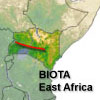 



Weather data
A large number of automatic weather stations has been implemented in the frame of the BIOTA AFRICA project by the Namibian National Botanical Research Institute (NBRI) and the Group "Biodiversity, Evolution and Ecology" (BEE) of the University of Hamburg. The website offers hourly updates of data and graphs of a large number of weather parameters.

|
 BIOTA East Africa - Workpackage(s)
BIOTA East Africa - Workpackage(s)
Subproject |
E03 - Regeneration of tropical trees - implications for forest conservation |
Workpackage |
WP3: Experimental restoration and rehabilitation of degraded forest sites and threatened tree species |
Project leader(s) |
Dr. Winfred Musila |
Project description |
Kakamega Forest has faced extensive deforestation, fragmentation and degradation over the last decades. Today, only about 50% of the forest cover 70 years ago remains The main agent of disturbance has been of human origin through activities such as selective logging, firewood collection, grazing, medicinal plants harvesting, clearing of forest land for settlement and agricultural purposes. Since early 1980's the government imposed stricter regulation to control further destruction and some parts of the forest have started to recover. However, the rate of recovery is very slow and in some parts the scale and extent of past human disturbance was severe to impair or prevent natural regeneration from taking place.
Factors that can delay or stop regeneration in degraded sites have been identified as; low soil fertility, soil compaction, lack of seeds (due to lack of plants that supply new seeds), depleted seed banks, unfavourable microclimatic conditions, emergence of aggressive herbaceous growth and high seed and seedling predation. There is hence need for human intervention to accelerate the rate of forest recovery.
Forest restoration, a process that aims to regain ecological integrity and enhance human well-being in deforested or degraded forest landscapes can help reverse some of the more severe impacts of forest loss and degradation. However, one key challenge for forest restoration is to identify the type and level of restoration that is compatible with social and biophysical realities.
An experimental restoration program aimed at rehabilitating degraded sites in Kakamega forest is proposed. Complementary restoration strategies will be deployed to achieve multiple functionality of the forest. These will include enrichment planting in shrublands and highly disturbed sites and installation of tree islands in the grasslands, ecological corridors and stepping stones between the main forest block and the fragments. Indigenous trees will be used because they are better adapted to the local environmental conditions, the seeds and propagules can be collected, in addition, using them helps to preserve genetic diversity. The choice of appropriate trees for restoration will depend on the species performance, their economic and environmental benefits, seed availability and information on silvicultural characteristics and management. |
Keywords |
Experimental restoration, rehabilitation of degraded forest sites, threatened tree species, main forest block, fragmented forest, corridor planting, enrichment planting, island planting, stakeholders acceptance, restoration manual |
Contribution to
cross-cutting themes (CCT) |
- Monitoring and assessment of biodiversity in space and time (Theme1)
- Understanding natural processes of change (Theme2)
- Recommendations and measures for sustainable use of biodiversity (Theme4)
|
Link to Subproject |
E11
E13
E14 |
|
|






 Go to the WeatherNet
Go to the WeatherNet BIOTA East Africa - Workpackage(s)
BIOTA East Africa - Workpackage(s)